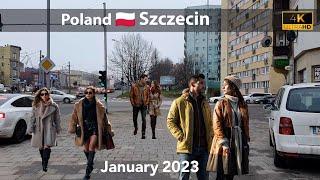
Street walk -Szczecin Poland - January 2024| 4k
🇵🇱 Szczecin Christmas market - https://youtu.be/UU_fjFxQG30?si=EWMMQgrC0kf-tKRu
Pay attention to my latest video that I shot for you in the mountains of Bulgaria, the city of 🇧🇬Pamporovo - https://youtu.be/jiAt9JWOcYM?si=Ypptp0L0UCojrOY9
Szczecin serves as the capital and largest city within the West Pomeranian Voivodeship, located in northwestern Poland. Positioned in proximity to the Baltic Sea and the German border, it holds significance as a major seaport, ranking as Poland's seventh-largest city.
Situated along the Oder River, south of the Szczecin Lagoon and the Bay of Pomerania, the city occupies the southwestern shoreline of Dąbie Lake. Szczecin spans both sides of the Oder, encompassing several sizable islands nestled between the river's western and eastern branches. Adjacent to the town of Police, it acts as the urban focal point for the Szczecin agglomeration, an extensive metropolitan area extending into the German states of Brandenburg and Mecklenburg-Western Pomerania.
Functioning as the administrative and industrial hub of the West Pomeranian Voivodeship, Szczecin hosts notable educational institutions such as the University of Szczecin, Pomeranian Medical University, Maritime University, West Pomeranian University of Technology, Szczecin Art Academy, and serves as the seat of the Szczecin-Kamień Catholic Archdiocese. The city's historical landmarks include the Szczecin Cathedral, the Pomeranian Dukes' Castle, and the National Museum. Since 1999, Szczecin has been the headquarters for NATO's Multinational Corps Northeast and was a candidate for the European Capital of Culture in 2016.
Regarding its name and etymology, Szczecin and Stettin represent the Polish and German variations of the same name, rooted in Proto-Slavic origins.
The precise etymology remains a topic of ongoing research, with 11 theories proposed by Maria Malec in her Etymological Dictionary of Geographical Names of Poland. These theories encompass potential derivations from an Old Slavic term denoting 'hill peak,' the plant fuller's teasel, or the personal name Szczota. In medieval times, the town was also referred to as Burstaborg (in the Knytlinga saga) and Burstenburgh (in the Annals of Waldemar), both translating to 'brush burgh,' likely stemming from the translation of the city's Slavic name.
#citytour #walking #poland #Szczecin
Pay attention to my latest video that I shot for you in the mountains of Bulgaria, the city of 🇧🇬Pamporovo - https://youtu.be/jiAt9JWOcYM?si=Ypptp0L0UCojrOY9
Szczecin serves as the capital and largest city within the West Pomeranian Voivodeship, located in northwestern Poland. Positioned in proximity to the Baltic Sea and the German border, it holds significance as a major seaport, ranking as Poland's seventh-largest city.
Situated along the Oder River, south of the Szczecin Lagoon and the Bay of Pomerania, the city occupies the southwestern shoreline of Dąbie Lake. Szczecin spans both sides of the Oder, encompassing several sizable islands nestled between the river's western and eastern branches. Adjacent to the town of Police, it acts as the urban focal point for the Szczecin agglomeration, an extensive metropolitan area extending into the German states of Brandenburg and Mecklenburg-Western Pomerania.
Functioning as the administrative and industrial hub of the West Pomeranian Voivodeship, Szczecin hosts notable educational institutions such as the University of Szczecin, Pomeranian Medical University, Maritime University, West Pomeranian University of Technology, Szczecin Art Academy, and serves as the seat of the Szczecin-Kamień Catholic Archdiocese. The city's historical landmarks include the Szczecin Cathedral, the Pomeranian Dukes' Castle, and the National Museum. Since 1999, Szczecin has been the headquarters for NATO's Multinational Corps Northeast and was a candidate for the European Capital of Culture in 2016.
Regarding its name and etymology, Szczecin and Stettin represent the Polish and German variations of the same name, rooted in Proto-Slavic origins.
The precise etymology remains a topic of ongoing research, with 11 theories proposed by Maria Malec in her Etymological Dictionary of Geographical Names of Poland. These theories encompass potential derivations from an Old Slavic term denoting 'hill peak,' the plant fuller's teasel, or the personal name Szczota. In medieval times, the town was also referred to as Burstaborg (in the Knytlinga saga) and Burstenburgh (in the Annals of Waldemar), both translating to 'brush burgh,' likely stemming from the translation of the city's Slavic name.
#citytour #walking #poland #Szczecin
Комментарии:
Street walk -Szczecin Poland - January 2024| 4k
Walking with RosT
PICO CABUGÍ-RN-BRA
Reniclebson Feitosa
( 1307 ) Đối diện sự thật. Buôn làng kéo đến đầy nhà làm người Mẹ Hoang Mang. Tập cuối.
TUẤN VỸ KẾT NỐI YÊU THƯƠNG
MALTA Study English Abroad /Estudia Inglés en el extranjero
Chilena por el Mundo
Vườn Rau Quê Tôi Đẹp Ra Sao - Góc Quê Hương TV
Góc Quê Hương TV
Oh chuva peço que caia devagar -Reni Souza
Reniclebson Feitosa
NESSAS HORAS - RENI SOUZA
Reniclebson Feitosa
Fantasma-Luan Santana
Reniclebson Feitosa


























